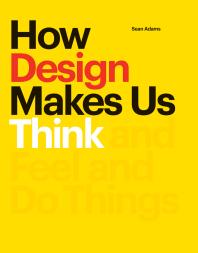
Check out these recent ebook additions to the RLB Library!
 Android Design Patterns: Interaction Design Solutions for Developers. Master the challenges of Android user interface development with these sample patterns With Android 4, Google brings the full power of its Android OS to both smartphone and tablet computing. Designing effective user interfaces that work on multiple Android devices is extremely challenging. This book provides more than 75 patterns that you can use to create versatile user interfaces for both smartphones and tablets, saving countless hours of development time. Patterns cover the most common and yet difficult types of user interactions, and each is supported with richly illustrated, step-by-step instructions. Includes sample patterns for welcome and home screens, searches, sorting and filtering, data entry, navigation, images and thumbnails, interacting with the environment and networks, and more Features tablet-specific patterns and patterns for avoiding results you don’t want Illustrated, step-by-step instructions describe what the pattern is, how it works, when and why to use it, and related patterns and anti-patterns A companion website offers additional content and a forum for interaction. Android Design Patterns: Interaction Design Solutions for Developers provides extremely useful tools for developers who want to take advantage of the booming Android app development market.
Android Design Patterns: Interaction Design Solutions for Developers. Master the challenges of Android user interface development with these sample patterns With Android 4, Google brings the full power of its Android OS to both smartphone and tablet computing. Designing effective user interfaces that work on multiple Android devices is extremely challenging. This book provides more than 75 patterns that you can use to create versatile user interfaces for both smartphones and tablets, saving countless hours of development time. Patterns cover the most common and yet difficult types of user interactions, and each is supported with richly illustrated, step-by-step instructions. Includes sample patterns for welcome and home screens, searches, sorting and filtering, data entry, navigation, images and thumbnails, interacting with the environment and networks, and more Features tablet-specific patterns and patterns for avoiding results you don’t want Illustrated, step-by-step instructions describe what the pattern is, how it works, when and why to use it, and related patterns and anti-patterns A companion website offers additional content and a forum for interaction. Android Design Patterns: Interaction Design Solutions for Developers provides extremely useful tools for developers who want to take advantage of the booming Android app development market.
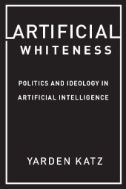 Artificial Whiteness: Politics and Ideology in Artificial Intelligence. Dramatic statements about the promise and peril of artificial intelligence for humanity abound, as an industry of experts claims that AI is poised to reshape nearly every sphere of life. Who profits from the idea that the age of AI has arrived? Why do ideas of AI’s transformative potential keep reappearing in social and political discourse, and how are they linked to broader political agendas?Yarden Katz reveals the ideology embedded in the concept of artificial intelligence, contending that it both serves and mimics the logic of white supremacy. He demonstrates that understandings of AI, as a field and a technology, have shifted dramatically over time based on the needs of its funders and the professional class that formed around it. From its origins in the Cold War military-industrial complex through its present-day Silicon Valley proselytizers and eager policy analysts, AI has never been simply a technical project enabled by larger data and better computing. Drawing on intimate familiarity with the field and its practices, Katz instead asks us to see how AI reinforces models of knowledge that assume white male superiority and an imperialist worldview. Only by seeing the connection between artificial intelligence and whiteness can we prioritize alternatives to the conception of AI as an all-encompassing technological force. Bringing together theories of whiteness and race in the humanities and social sciences with a deep understanding of the history and practice of science and computing, Artificial Whiteness is an incisive, urgent critique of the uses of AI as a political tool to uphold social hierarchies.
Artificial Whiteness: Politics and Ideology in Artificial Intelligence. Dramatic statements about the promise and peril of artificial intelligence for humanity abound, as an industry of experts claims that AI is poised to reshape nearly every sphere of life. Who profits from the idea that the age of AI has arrived? Why do ideas of AI’s transformative potential keep reappearing in social and political discourse, and how are they linked to broader political agendas?Yarden Katz reveals the ideology embedded in the concept of artificial intelligence, contending that it both serves and mimics the logic of white supremacy. He demonstrates that understandings of AI, as a field and a technology, have shifted dramatically over time based on the needs of its funders and the professional class that formed around it. From its origins in the Cold War military-industrial complex through its present-day Silicon Valley proselytizers and eager policy analysts, AI has never been simply a technical project enabled by larger data and better computing. Drawing on intimate familiarity with the field and its practices, Katz instead asks us to see how AI reinforces models of knowledge that assume white male superiority and an imperialist worldview. Only by seeing the connection between artificial intelligence and whiteness can we prioritize alternatives to the conception of AI as an all-encompassing technological force. Bringing together theories of whiteness and race in the humanities and social sciences with a deep understanding of the history and practice of science and computing, Artificial Whiteness is an incisive, urgent critique of the uses of AI as a political tool to uphold social hierarchies.
 A Black Gaze: Artists Changing How We See. Examining the work of contemporary Black artists who are dismantling the white gaze and demanding that we see—and see Blackness in particular—anew. In A Black Gaze, Tina Campt examines Black contemporary artists who are shifting the very nature of our interactions with the visual through their creation and curation of a distinctively Black gaze. Their work—from Deana Lawson’s disarmingly intimate portraits to Arthur Jafa’s videos of the everyday beauty and grit of the Black experience, from Khalil Joseph’s films and Dawoud Bey’s photographs to the embodied and multimedia artistic practice of Okwui Okpakwasili, Simone Leigh, and Luke Willis Thompson—requires viewers to do more than simply look; it solicits visceral responses to the visualization of Black precarity.Campt shows that this new way of seeing shifts viewers from the passive optics of looking at to the active struggle of looking with, through, and alongside the suffering—and joy—of Black life in the present. The artists whose work Campt explores challenge the fundamental disparity that defines the dominant viewing practice: the notion that Blackness is the elsewhere (or nowhere) of whiteness. These artists create images that flow, that resuscitate and revalue the historical and contemporary archive of Black life in radical ways. Writing with rigor and passion, Campt describes the creativity, ingenuity, cunning, and courage that is the modus operandi of a Black gaze.
A Black Gaze: Artists Changing How We See. Examining the work of contemporary Black artists who are dismantling the white gaze and demanding that we see—and see Blackness in particular—anew. In A Black Gaze, Tina Campt examines Black contemporary artists who are shifting the very nature of our interactions with the visual through their creation and curation of a distinctively Black gaze. Their work—from Deana Lawson’s disarmingly intimate portraits to Arthur Jafa’s videos of the everyday beauty and grit of the Black experience, from Khalil Joseph’s films and Dawoud Bey’s photographs to the embodied and multimedia artistic practice of Okwui Okpakwasili, Simone Leigh, and Luke Willis Thompson—requires viewers to do more than simply look; it solicits visceral responses to the visualization of Black precarity.Campt shows that this new way of seeing shifts viewers from the passive optics of looking at to the active struggle of looking with, through, and alongside the suffering—and joy—of Black life in the present. The artists whose work Campt explores challenge the fundamental disparity that defines the dominant viewing practice: the notion that Blackness is the elsewhere (or nowhere) of whiteness. These artists create images that flow, that resuscitate and revalue the historical and contemporary archive of Black life in radical ways. Writing with rigor and passion, Campt describes the creativity, ingenuity, cunning, and courage that is the modus operandi of a Black gaze.
 Conversational Problem Solving. This book features mathematical problems and results that would be of interest to all mathematicians, but especially undergraduates (and even high school students) who participate in mathematical competitions such as the International Math Olympiads and Putnam Competition. The format is a dialogue between a professor and eight students in a summer problem solving camp and allows for a conversational approach to the problems as well as some mathematical humor and a few nonmathematical digressions. The problems have been selected for their entertainment value, elegance, trickiness, and unexpectedness, and have a wide range of difficulty, from trivial to horrendous. They range over a wide variety of topics including combinatorics, algebra, probability, geometry, and set theory. Most of the problems have not appeared before in a problem or expository format. A Notes section at the end of the book gives historical information and references.
Conversational Problem Solving. This book features mathematical problems and results that would be of interest to all mathematicians, but especially undergraduates (and even high school students) who participate in mathematical competitions such as the International Math Olympiads and Putnam Competition. The format is a dialogue between a professor and eight students in a summer problem solving camp and allows for a conversational approach to the problems as well as some mathematical humor and a few nonmathematical digressions. The problems have been selected for their entertainment value, elegance, trickiness, and unexpectedness, and have a wide range of difficulty, from trivial to horrendous. They range over a wide variety of topics including combinatorics, algebra, probability, geometry, and set theory. Most of the problems have not appeared before in a problem or expository format. A Notes section at the end of the book gives historical information and references.
 The Great Exception: The New Deal and the Limits of American Politics. How the New Deal was a unique historical moment and what this reveals about U.S. politics, economics, and culture. Where does the New Deal fit in the big picture of American history? What does it mean for us today? What happened to the economic equality it once engendered? In The Great Exception, Jefferson Cowie provides new answers to these important questions. In the period between the Great Depression and the 1970s, he argues, the United States government achieved a unique level of equality, using its considerable resources on behalf of working Americans in ways that it had not before and has not since. If there is to be a comparable battle for collective economic rights today, Cowie argues, it needs to build on an understanding of the unique political foundation for the New Deal. Anyone who wants to come to terms with the politics of inequality in the United States will need to read The Great Exception.
The Great Exception: The New Deal and the Limits of American Politics. How the New Deal was a unique historical moment and what this reveals about U.S. politics, economics, and culture. Where does the New Deal fit in the big picture of American history? What does it mean for us today? What happened to the economic equality it once engendered? In The Great Exception, Jefferson Cowie provides new answers to these important questions. In the period between the Great Depression and the 1970s, he argues, the United States government achieved a unique level of equality, using its considerable resources on behalf of working Americans in ways that it had not before and has not since. If there is to be a comparable battle for collective economic rights today, Cowie argues, it needs to build on an understanding of the unique political foundation for the New Deal. Anyone who wants to come to terms with the politics of inequality in the United States will need to read The Great Exception.
How Design Makes Us Think: and Feel and Do Things. From posters to cars, design is everywhere. While we often discuss the aesthetics of design, we don’t always dig deeper to unearth the ways design can overtly, and covertly, convince us of a certain way of thinking. How Design Makes Us Think collects hundreds of examples across graphic design, product design, industrial design, and architecture to illustrate how design can inspire, provoke, amuse, anger, or reassure us. Graphic designer Sean Adams walks us through the power of design to attract attention and convey meaning. The book delves into the sociological, psychological, and historical reasons for our responses to design, offering practitioners and clients alike a new appreciation of their responsibility to create design with the best intentions. How Design Makes Us Think is an essential read for designers, advertisers, marketing professionals, and anyone who wants to understand how the design around us makes us think, feel, and do things. From posters to cars, design is everywhere. While we often discuss the aesthetics of design, we don’t always dig deeper to unearth the ways design can overtly, and covertly, convince us of a certain way of thinking. How Design Makes Us Think collects hundreds of examples across graphic design, product design, industrial design, and architecture to illustrate how design can inspire, provoke, amuse, anger, or reassure us. Graphic designer Sean Adams walks us through the power of design to attract attention and convey meaning. The book delves into the sociological, psychological, and historical reasons for our responses to design, offering practitioners and clients alike a new appreciation of their responsibility to create design with the best intentions. How Design Makes Us Think is an essential read for designers, advertisers, marketing professionals, and anyone who wants to understand how the design around us makes us think, feel, and do things.
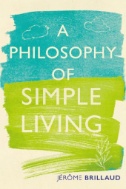 A Philosophy of Simple Living. Today, “simple living” is a rallying cry for anti-consumerists, environmentalists, and anyone concerned with humanity’s effect on the planet. But what is so revolutionary about a simple life? And why are we so fascinated with simplicity today? A Philosophy of Simple Living charts the ideas, motivations, and practices of simplicity from antiquity to the present day. Bringing together an array of people, practices, and movements, from Henry David Thoreau to Steve Jobs, and from Cynics and Shakers to the “slow movement,” voluntary simplicity, and degrowth, this book is as comprehensive as it is concise. Written in elegant, spare prose, A Philosophy of Simple Living will be of great benefit to all who wish to declutter and pare back their complicated, modern lives.
A Philosophy of Simple Living. Today, “simple living” is a rallying cry for anti-consumerists, environmentalists, and anyone concerned with humanity’s effect on the planet. But what is so revolutionary about a simple life? And why are we so fascinated with simplicity today? A Philosophy of Simple Living charts the ideas, motivations, and practices of simplicity from antiquity to the present day. Bringing together an array of people, practices, and movements, from Henry David Thoreau to Steve Jobs, and from Cynics and Shakers to the “slow movement,” voluntary simplicity, and degrowth, this book is as comprehensive as it is concise. Written in elegant, spare prose, A Philosophy of Simple Living will be of great benefit to all who wish to declutter and pare back their complicated, modern lives.
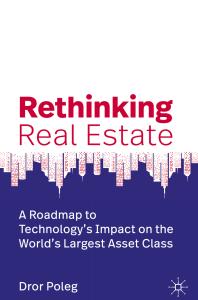 Rethinking Real Estate: a Roadmap to Technology’s Impact on the World’s Largest Asset Class. Technology is revolutionizing the way real estate is designed, operated, and valued. It is democratizing access to capital and information, changing the way tenants use space, and eroding the power of regulation. Billions of dollars are funding these new real estate technologies and operating models. Value is shifting away from the assets themselves toward those who understand the needs of specific end-users and can use technology to deliver comprehensive, on-demand solutions. With all of these developments, there is an urgent need for a resource that helps industry practitioners think differently about their investment, customers, and competition. Rethinking Real Estate answers that call. It explores the impact of technology on all asset types — from retail projects, through lodging and residential properties, to office buildings and industrial facilities. Based on the author’s two decades of experience working across four continents alongside the world’s leading real estate investors, as well as hundreds of conversations with start-up founders and venture capitalists, this book provides practitioners with key insights, methodologies, and practical strategies to identify risks, take advantage of emerging opportunities, evaluate new competitors, and transform their organization, project, venture, or career. Whether you are an investor, developer, operator, broker, lender, facility manager, designer, planner, or technology entrepreneur, this book will help you navigate the exciting period ahead.
Rethinking Real Estate: a Roadmap to Technology’s Impact on the World’s Largest Asset Class. Technology is revolutionizing the way real estate is designed, operated, and valued. It is democratizing access to capital and information, changing the way tenants use space, and eroding the power of regulation. Billions of dollars are funding these new real estate technologies and operating models. Value is shifting away from the assets themselves toward those who understand the needs of specific end-users and can use technology to deliver comprehensive, on-demand solutions. With all of these developments, there is an urgent need for a resource that helps industry practitioners think differently about their investment, customers, and competition. Rethinking Real Estate answers that call. It explores the impact of technology on all asset types — from retail projects, through lodging and residential properties, to office buildings and industrial facilities. Based on the author’s two decades of experience working across four continents alongside the world’s leading real estate investors, as well as hundreds of conversations with start-up founders and venture capitalists, this book provides practitioners with key insights, methodologies, and practical strategies to identify risks, take advantage of emerging opportunities, evaluate new competitors, and transform their organization, project, venture, or career. Whether you are an investor, developer, operator, broker, lender, facility manager, designer, planner, or technology entrepreneur, this book will help you navigate the exciting period ahead.
 Refugee High: Coming of Age in America. A year in the life of a Chicago high school that has one of the highest proportions of refugees of any school in the nation “A wondrous tapestry of stories, of young people looking for a home. With deep, immersive reporting, Elly Fishman pulls off a triumph of empathy. Their tales and their school speak to the best of who we are as a nation—and their struggles, their joys, their journeys will stay with you.” —Alex Kotlowitz, author of There Are No Children Here Winner of the Studs and Ida Terkel Award For a century, Chicago’s Roger C. Sullivan High School has been a home to immigrant and refugee students. In 2017, during the worst global refugee crisis in history, its immigrant population numbered close to three hundred—or nearly half the school—and many were refugees new to the country. These young people came from thirty-five different countries, speaking among themselves more than thirty-eight different languages. For these refugee teens, life in Chicago is hardly easy. They have experienced the world at its worst and carry the trauma of the horrific violence they fled. In America, they face poverty, racism, and xenophobia, but they are still teenagers—flirting, dreaming, and working as they navigate their new life in America. Refugee High is a riveting chronicle of the 2017–8 school year at Sullivan High, a time when anti-immigrant rhetoric was at its height in the White House. Even as we follow teachers and administrators grappling with the everyday challenges facing many urban schools, we witness the complicated circumstances and unique education needs of refugee and immigrant children: Alejandro may be deported just days before he is scheduled to graduate; Shahina narrowly escapes an arranged marriage; and Belenge encounters gang turf wars he doesn’t understand. Equal parts heartbreaking and inspiring, Refugee High raises vital questions about the priorities and values of a public school and offers an eye-opening and captivating window into the present-day American immigration and education systems.
Refugee High: Coming of Age in America. A year in the life of a Chicago high school that has one of the highest proportions of refugees of any school in the nation “A wondrous tapestry of stories, of young people looking for a home. With deep, immersive reporting, Elly Fishman pulls off a triumph of empathy. Their tales and their school speak to the best of who we are as a nation—and their struggles, their joys, their journeys will stay with you.” —Alex Kotlowitz, author of There Are No Children Here Winner of the Studs and Ida Terkel Award For a century, Chicago’s Roger C. Sullivan High School has been a home to immigrant and refugee students. In 2017, during the worst global refugee crisis in history, its immigrant population numbered close to three hundred—or nearly half the school—and many were refugees new to the country. These young people came from thirty-five different countries, speaking among themselves more than thirty-eight different languages. For these refugee teens, life in Chicago is hardly easy. They have experienced the world at its worst and carry the trauma of the horrific violence they fled. In America, they face poverty, racism, and xenophobia, but they are still teenagers—flirting, dreaming, and working as they navigate their new life in America. Refugee High is a riveting chronicle of the 2017–8 school year at Sullivan High, a time when anti-immigrant rhetoric was at its height in the White House. Even as we follow teachers and administrators grappling with the everyday challenges facing many urban schools, we witness the complicated circumstances and unique education needs of refugee and immigrant children: Alejandro may be deported just days before he is scheduled to graduate; Shahina narrowly escapes an arranged marriage; and Belenge encounters gang turf wars he doesn’t understand. Equal parts heartbreaking and inspiring, Refugee High raises vital questions about the priorities and values of a public school and offers an eye-opening and captivating window into the present-day American immigration and education systems.
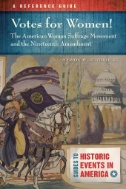 Votes for Women! The American Woman Suffrage Movement and the Nineteenth Amendment: a Reference Guide. This contextual narrative of the 70-year history of the woman suffrage movement in the United States demonstrates how an important mass political and social movement coalesced into a political force despite class, racial, ethnic, religious, and regional barriers.Votes for Women! provides an updated consideration of the questions raised by the mass movement to gain equality and access to power in our democracy. It interprets the campaigns for woman suffrage from the 1830s until 1920, analyzes the impact of the Nineteenth Amendment, and presents primary documents to allow a glimpse into the minds of those who campaigned for and against woman suffrage.The book’s examination of the 70-year woman suffrage campaign shows how the movement faced enormous barriers, was perceived as threatening the very core of accepted beliefs, and was a struggle that showcased the efforts of strong protagonists and brilliant organizers who were intellectually innovative and yet were reflective of the great divides of race, ethnicity, religion, economics, and region existing across the nation.
Votes for Women! The American Woman Suffrage Movement and the Nineteenth Amendment: a Reference Guide. This contextual narrative of the 70-year history of the woman suffrage movement in the United States demonstrates how an important mass political and social movement coalesced into a political force despite class, racial, ethnic, religious, and regional barriers.Votes for Women! provides an updated consideration of the questions raised by the mass movement to gain equality and access to power in our democracy. It interprets the campaigns for woman suffrage from the 1830s until 1920, analyzes the impact of the Nineteenth Amendment, and presents primary documents to allow a glimpse into the minds of those who campaigned for and against woman suffrage.The book’s examination of the 70-year woman suffrage campaign shows how the movement faced enormous barriers, was perceived as threatening the very core of accepted beliefs, and was a struggle that showcased the efforts of strong protagonists and brilliant organizers who were intellectually innovative and yet were reflective of the great divides of race, ethnicity, religion, economics, and region existing across the nation.
